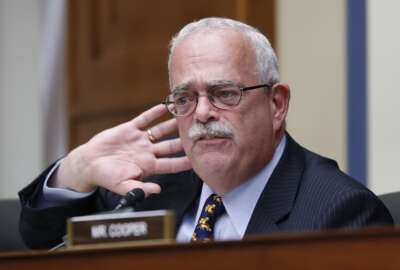
IG’s concerns over OPM-GSA merger persist as reorganization remains in flux
The inspector general at the Office of Personnel Management said the uncertainty surrounding the agency's proposed merger with the General Services Administration...
The Trump administration’s proposed merger of the Office of Personnel Management with the General Services Administration is still on the mind of the agency’s inspector general.
OPM’s inspector general in May presented a critical assessment of the administration’s efforts to justify the GSA merger.
But many of the IG’s concerns then remain today, as OPM still largely doesn’t have a documented plan, cost-benefit analysis and timeline for the proposed merger, Norbert Vint, OPM’s deputy inspector general performing the duties of the IG, wrote in a recent report detailing the agency’s ongoing management challenges.
“The specific details of the full OPM/GSA merger continue to evolve and every iteration of the proposed reorganization would fundamentally alter how agency functions and duties are performed,” the IG wrote.
Beyond the IG’s latest anecdotes about the proposed OPM-GSA merger, here are five other highlights that illustrate the agency’s ongoing challenges — and a few points of progress — headed into fiscal 2020.
IG concerns with OPM-GSA merger persist
Though OPM seems to be aware of the risks of the merger — the IG noted the agency was using a Six Sigma process designed for mergers and acquisitions to monitor and steer the reorganization — OPM still lacks a timeline, a cost-benefit analysis and an explanation of what legislative or administrative authorities it will use to carry out all or parts of the proposal.
A series of alternatives to the OPM-GSA merger is missing as well, Vint said.
This is especially evident, the IG said, when it comes to the administration’s plans to transfer the Performance Accountability Council, the Chief Human Capital Officers Council and the Performance Management Office.
The administration said this past summer it would move the administrative staff and support for these councils to GSA. Yet cost-benefit analyses of these transfers haven’t been completed, the IG said, and OPM can’t guarantee the staff currently working for these councils will retain employment for their organizations at GSA.
“The agency has not conducted a business or cost-benefit analysis to justify the move of either council,” the IG wrote. “For example, the staff subject to the transition of the Chief Human Capital Officers Council to GSA would be appointed to new positions non-competitively once GSA cleared the positions through the inter-agency career transition assistance plan. Not only does this process not guarantee current OPM staff reemployment at GSA, OPM has not conducted an assessment of the costs associated with this workforce restructuring.”
Beyond the basic planning for the OPM-GSA merger, the IG urged the agency to continue to educate the workforce about its plans for the reorganization to keep them “engaged and productive.” It also noted staff surveys showed “confusion and uncertainty related to the proposed merger.”
NBIB transfer went well, IT untangling more complex
Pentagon officials have applauded a relatively smooth transition of OPM’s National Background Investigations Bureau to the Defense Department in recent months, and the effort earned some praise from the OPM IG as well.
Vint said NBIB and DoD spearheaded the transfer of OPM employees from Title 5 to Title 10, created a working capital fund at the Pentagon and made plans for the ongoing upkeep of legacy IT systems.
“We are … encouraged both by the dialogue between the two agencies, as well as by NBIB’s efforts to thoroughly study and document this transfer,” Vint wrote.
The IG also praised OPM and the administration for securing $48 million in additional appropriations for the agency this year. OPM suffered an immediate budget shortfall of $70 million when NBIB and the security clearance business moved to the Pentagon.
What comes next, however, will be much trickier.
The Defense Counterintelligence and Security Agency will continue to use OPM’s legacy case management systems until the Pentagon completes the development of a series of brand new systems, called the National Background Investigations Service.
NBIS development will take some time, the IG said, untangling legacy systems from the rest of OPM’s IT systems will be a “significant short-term challenge for the agency.”
“Complicating the transfer is that the NBIB systems reside on OPM’s mainframe, which are tightly integrated with other OPM legacy systems,” Vint wrote. “OPM’s CIO indicated that the plan is to untangle the NBIB systems from these other systems and transfer responsibility for hosting and managing them to DCSA. While this does make some sense, it will be technically challenging and costly to achieve.”
Prescription drug costs make up quarter of FEHBP
The cost of prescription drugs makes up 27% of the total expenditures in the Federal Employees Health Benefits Program, and OPM needs a long-term strategy to manage those rising costs in the future, the IG said.
“We believe the need for clear and extensive analysis of the FEHBP drug program cost-saving options is long overdue,” Vint wrote. “The last time OPM formally studied the issue was approximately nine years ago. The PBM and prescription drug landscape has significantly changed since 2010.”
The opioid epidemic also complicates OPM’s efforts to keep FEHBP costs down.
Between 2012 and 2018, 26,000 FEHB participants received emergency care for opioid overdoses to the tune of $11 million, according to the IG. The program also spent $151.2 million on opioid antagonist prescriptions, such as naloxone, during that same time period.
Though OPM has made opioid treatment and prevention a priority in its call letters to FEHB carriers in recent years, the IG sees room to simplify FEHB program data and create a single repository of information.
Currently, OPM relies on FEHB carriers to self-report on how they’re complying with the agency priorities for the program.
“The complicated and layered nature of carriers and subcontractors should encourage OPM to explore a single data repository for claims information and a dedicated program integrity office to
provide a single source of internal controls, oversight and trend analysis as part of
agency efforts to combat the opioid crisis,” the IG wrote.
Progress on improper payments?
OPM’s retirement services noted some progress on its improper payment rate in recent years, according to the IG. The rate fell slightly from 0.38% in fiscal 2017 to 0.36% in 2018, with totals for the Civil Service Retirement and Disability Fund falling from $313.8 million to $284 million during that time.
This is one of the lower improper payment rates among agencies who disperse benefits in government, the IG said.
However, the IG still considers OPM’s improper payment rate to be a high risk, and it suggested the agency continue its efforts to modernize retirement processing and develop a claims tracking system.
Improper payments for the FEHBP, however, increased significantly — from $28 million in 2017 to $71.4 million in 2018, according to Vint. The IG said it’s concerned these rates are quite accurate and may not be calculated correctly.
Retirement claims are a mixed bag
OPM did, in fact, meet its stated goals for processing retirement claims in recent months, according to the IG. On average, the agency completed retirement claims in an average of 56 days between October 2018 through July 2019.
But OPM’s response times on its customer service phone line averaged 12 minutes during that same time period, well above the agency’s goal of five minutes.
Still, the IG noted some steps the agency has taken in recent years to modernize the retirement claims process, a project that’s moved slowly in fits and starts for the past two decades. OPM, for example, has completed at least one out of seven planned agile sprints to develop an online retirement application form, Vint said.
Copyright © 2025 Federal News Network. All rights reserved. This website is not intended for users located within the European Economic Area.
Nicole Ogrysko is a reporter for Federal News Network focusing on the federal workforce and federal pay and benefits.
Follow @nogryskoWFED
Related Stories





